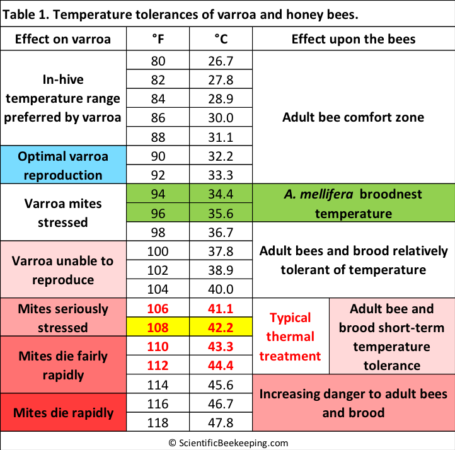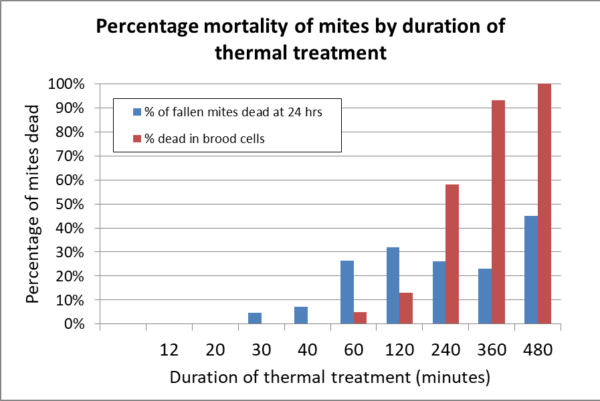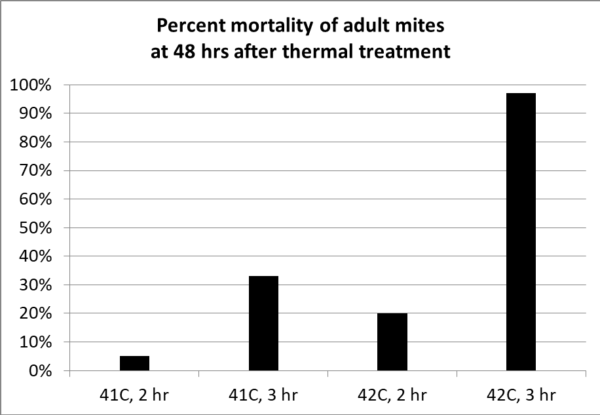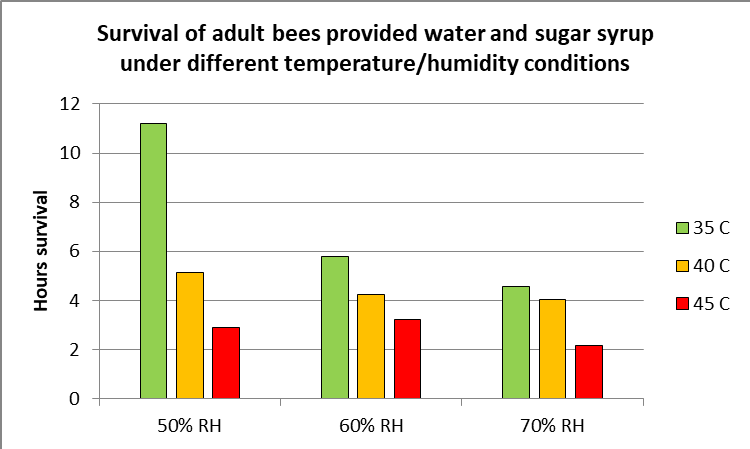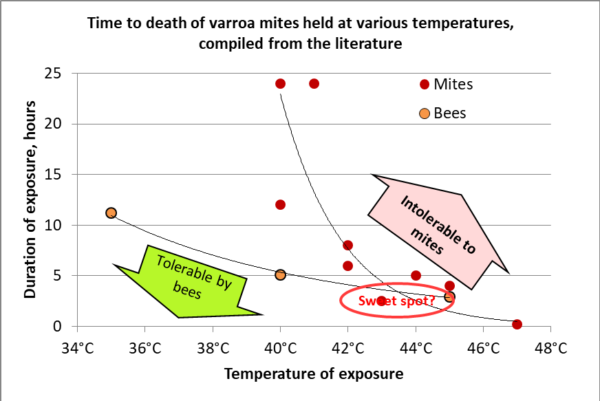A Test of Thermal Treatment for Varroa: Part 1
Beekeeper-funded Research
A Test of Thermal Treatment for Varroa:
Part 1
First published in ABJ March 2021
Randy Oliver
ScientificBeekeeping.com
Last month I wrapped up the report on my testing of mite treatments suitable for application during a honey flow. A number of beekeepers have also asked me about using thermal treatment. I found that there was scant data available on the subject, so I ran a small test myself. But before I share my results, I’d like to review what we currently know about thermal treatment.
BACKGROUND AND HISTORY
Adult varroa mites in the hive appear to prefer temperatures in the range of 79 and 91 F (26 and 33 C) [[1]]. As far as the mite’s ability to reproduce, Le Conte [[2]] found that the optimal temperature for varroa reproduction was between 90 and 94 F (32.5 and 33.4 C). Note that this is a bit lower than the temperature at which Apis mellifera maintain their brood (approximately 94–95 F (34.5–35 C)). Above 100 F (38 C), female mites began to die without reproducing.
Kraus [[3]] followed up on Le Conte’s research, and carefully measured broodnest temperatures in Apis cerana hives. They found that A. cerana does not thermoregulate the brood as closely as does A. mellifera, and the authors make the case that varroa is better adapted to brood held at 92 F (33 C), than at the higher temperature typical of A. mellifera. Kraus proposed that this may be a regulatory factor that the Asian bee uses against the parasite.
Practical application: It appears that varroa is still adapted to the lower temperatures maintained by its original host, and has not yet fully adapted to Apis mellifera. And also, with respect to this article, that varroa starts to stress at temperatures lower than those tolerable by bees.
However, in order to disperse from hive to hive, mites must be able to deal with short-duration heat spikes, since hitchhiking mites can survive on bees flying with thoracic temperatures of 105 F (40 C). Le Conte exposed mites in cells to a range of temperatures and durations, and found that 12 hrs exposure to 106 F (41 C) would kill nearly half the mites, and 6 hrs exposure at 108 F (42 C) would kill nearly all of them. But 2 hrs exposure at 108 F (42 C) killed very few.
Adult honey bees, on the other hand, appear to be able to handle short-term exposure to temperatures as high as 110F (44 C) [[4]]. It didn’t take long for researchers to realize that due to the differences in temperature tolerance of bees and mites, that we might be able to use high-temperature (hyperthermia) to control varroa.
In order to allow you to unscramble your brain from all the converted numbers, I’ve created a table for honey bee and varroa temperature tolerance (Table 1).
Practical application: Note above the relatively narrow range of temperature for thermal treatment at which we can kill the mites without hurting the bees. I’ve highlighted in yellow what appears to be the minimal temperature required to kill most of the mites in the brood within 3 hours of treatment.
HOW MUCH WIGGLE ROOM IS THERE?
Harbo [[5]], in the year 2000, after testing thermal treatment to remove mites from adult bees, concluded that:
Even 40°C, the lowest temperature that can remove all the mites [from caged adult bees], is perilously close to temperatures that kill bees.
So just how much wiggle room do we have? If we want to kill a parasite while it’s on or in its host, we want to use a treatment that has a wide margin of safety between its lethal levels to the two species. The margin of safety is often expressed as a “selectivity ratio” — for varroa treatments, calculated by dividing the dose that kills bees by the dose that kills mites. In Table 2, I’ve listed some approximated selectivity ratios for some common varroa treatments.
| Table 2. Approximate selectivity ratios of common miticides. | ||
| Treatment | Selectivity ratio | Author |
| Amitraz | 7000:1 | Santiago[[6]] |
| Fluvalinate | 1000-4000:1 | Santiago, Lindberg[[7]] |
| Oxalic acid | 400:1 | Aliano [[8]] |
| Formic acid | 2-4:1 | Lindberg |
| Thymol | 3-4:1 | Lindberg, Imdorf [[9]] |
Note how much a wider margin of safety there is for the synthetic acaricides than for the organic acids or thymol. By comparison, the margin of safety for thermal treatment is tiny. Refer back to Table 1 to see that there’s only a few degrees difference between the temperature required to kill mites in the brood, and that which starts to harm the bees themselves.
Dalman [[10]] recently confirmed that worker bees suffer adverse effects at temperatures above 40 C (104 F) over the long term, and from even an hour’s exposure to 43 C (110 F). As a side note, although they found that high temperature may suppress virus multiplication, they concluded that thermal treatment was not a useful tool to control viruses in bees.
Practical application: Exposing bees to temperatures only a few degrees higher than normal broodnest temperature has the potential to harm them. The challenge then is that it takes such a high temperature for some period of time in order to kill the mites. Thus, any thermal treatment device or system must control the temperature precisely within a narrow range, for a specific number of minutes or hours.
So let’s take a look into exactly what we know about the required temperatures and durations of treatment required.
USING HYPERTHERMIA TO KILL MITES
Years ago, when I was visiting beekeeper Leonid Zaytsev in Oregon, he showed me a screened tumbler that Russian beekeepers had long used to shake adult bees into, so as to heat them up temporarily to kill the mites. As explained by Harbo:
Bees are removed from their colony in autumn when there is very little brood. They are caged, placed in a chamber, and rapidly heated to 46 °-48°C (RH ~ 20%) until mites stop falling from the bees (c. 2-15 min). This technique is 85-95% effective.
Update: Jeff Cunningham performed a SARE project of testing the method in 1996. Read it at https://projects.sare.org/project-reports/lne96-066/
The above treatment was both tedious, and wasn’t of much use when colonies contained brood (which typically contains 50-75% of the mites in the hive). Appel and Büchler [[11]] in 1991 tested a thermal chamber to treat frames of brood without adult bees:
100% of the mites were killed after at least 4 h treatment with 44 °C… A 4-h treatment at 44 °C had a limited but non significant…effect on bee longevity; no difference was recorded in emergence rate and food consumption. Stronger treatments, in particular a rise in temperature to 45 °C, had a negative and frequently significant effect on emergence rate and longevity of bees. Younger brood (9 -10 d) reacted in the most sensitive manner…In principle, heat treatment of trapping combs seems suitable for Varroa control, but this technique requires exactitude in controlling temperature and heat regulation.
Another device is the Thermosolar Hive [[12]]. This design uses glass windows to absorb the sun’s heat, and maintains an elevated internal temperature during the course of treatment. The beekeeper must monitor the temperature and manually replace the window covers to avoid overheating. An open entrance is maintained for the adult bees to move out. I was surprised by the manufacturer’s own measurements of the temperature reached in the broodnest — holding at up to 117 F (46.7 C). Their data [[13]] indicate good mite control. They do recommend retreatment to hit any returning mites that were on the adult bees during treatment, after they’ve reentered the brood.
There’s also the Varroa Controller, into which the beekeeper places adult-bee-free combs of brood for thermal treatment (temperature not specified). They have a very informative online book about varroa management [[14]], which describes how to use the device, in commendable German detail. Of interest is that this device uses distilled water to maintain humidity during treatment. They claim 60–80% kill of the mites in the treated brood frames. Of interest, they state that mites may continue to die for up to 50 hours after treatment, a point that I kept in mind when I dissected brood to confirm mite kill in my own testing of thermal treatment.
The device was tested by Bičík [[15]], who confirmed 99-100% mite kill in the brood frames, following holding them at a temperature of 40 – 47 °C (104 – 116.6 °F) for 2½ hours.
THE REQUIRED DURATION OF TREATMENT
A Greek company patented the Thermovar device, which is attached to a colony with minimal brood to create a closed system from which the bees cannot escape. The device then circulates heated air through the hive. Of great interest is the meticulous data from tests of the device by Goras [[16]]. In their trial, in which they measured the air temperature between the combs:
The device temperature was adjusted to 42°C and the thermal treatment was applied on 27 complete bee colonies for a time range of 12 to 480 minutes. The duration we used in particular was 12, 20, 30, 40, 60, 120, 240, 360 and 480 minutes… During treatment the temperature varied from 42.3 to [over] 46.5 C. This high temperature did not last long, since the bees managed to reduce it by actively evaporating water…
They then counted dead bees, fallen mites, and also dissected the brood to determine percent mite kill.
No losses of adult bees were observed even after 480 minutes of treatment. Up to 120 minutes of treatment the brood was not affected negatively, whereas after 240 minutes, a percentage from 6% to 50% of the larvae [ceased] to develop and died. The development of the treated bee colonies was normal and no delay was observed in the following months compared to other colonies of the same apiary which were not subjected to hyperthermia.
I’ve graphed their findings below (Figure 1).
Figure 1. The findings of Goras, using the Thermovar device, set at 42 C. Note that although mites may drop from the bees, that doesn’t mean that they are dead (at least 55% recovered). Also note that substantial mite kill in the brood doesn’t even begin until after two hours of thermal treatment. It took a full six hours of cooking to reach a 90% kill of the mites in the brood!
Practical application: Goras’ data is really helpful to see the effect of treatment at 42 C (108 F). No adult bees died, but brood started to die after 4 hours of treatment. Lots of mites fell, but most were still viable even after 8 hours of hyperthermia. It took 4 hours to obtain appreciable kill of the mites in the brood, and a full 8 hours to attain 100% kill. The take-home message is that a temperature of even 42 C may be barely enough to obtain good efficacy of mite kill.
A very recent paper by Kablau is also of interest [[17]], whose data I’ve graphed below (Figure 2). Kablau placed adult-bee-free brood combs in a high-humidity (70-90% RH) incubator for treatment, and measured the actual temperature inside the brood combs.
Fig. 2. I’ve simplified Kablau’s findings, by only showing mite mortality at 48 hours after treatment, since there was a slight increase from that at 24 hours. Not shown is their finding that immature mites suffered 100% mortality from all four treatments. Note that a temperature of 41 C was inadequate, and even 42 C took 3 hours for good control.
Kablau teased out the difference in efficacies for the temperatures of 41 and 42 C, with his results indicating that 42 C would be a practical minimum. An important note is the Kablau found that thermal treatment only one degree higher (43 C (110 F)) also killed the drone brood, but at 41 C, not only did the drone brood survive, but the sperm in those drones, once they emerged, was unharmed. Kablau thus concluded that:
Hyperthermia treatment using temperatures above 42°C reliably killed both adult and immature mites, similar to what has been shown by Goras… Unfortunately, these high temperatures also killed the drone brood. Therefore, this treatment is unsuitable for removing Varroa destructor from a honeybee colony. Treatment at 41°C for 2 hours effectively killed immature Varroa destructor while not affecting drone vitality or fertility. Thus we can effectively interrupt the reproductive cycle of Varroa destructor without harming honeybee drones.
Practical application: Kablau’s concern about harming drone brood would not be shared by many beekeepers, since sacrifice of drone brood is commonly performed for varroa management. I also wonder whether killing only 30% of the adult mites in the brood would make thermal treatment worthwhile. The take home is that it appears to take at least 3 hours at 42 C (108 F) to kill most of the mites in the brood, provided that high humidity is maintained.
And this brings us to a key point — Kablau attained better mite kill in the brood at 42 C in three hours than did Goras in 6 hours. Why? It appears to be due to the fact that only Kablau’s device maintained high humidity. But Kablau was not testing for adverse effects upon adult bees from the high humidity maintained in his treatment chamber. And that brings us to the question…
IS HUMIDITY IMPORTANT?
As I look into thermal treatment, I note that some devices or laboratory experiments allow for free exit of adult bees and air, whereas some confine the adult bees and brood in a heated chamber, and in others the beekeeper places only brood combs in the device. In some setups, high humidity is maintained by a water reservoir. But only a few studies have tested mite and bee mortality under thermal treatment at different humidities.
When one warms liquid water, its vapor pressure increases more rapidly than does that of the other gases in air. This results in more rapid evaporation of the water. Perhaps counterintuitively, the higher the content of water vapor in air, the less dense that air becomes, resulting in a thermoconvection force of that water vapor upward. This detail may be important in the design of thermal treatment devices that do not have a fan or leave the hive entrance open.
During heat treatment, bees on the combs will attempt to reduce the temperature by fanning and evaporating water. If the device is designed to maintain high humidity, it can prevent such evaporative cooling.
On the flip side, if water vapor is allowed to escape and be replaced with cooler incoming air, then both the adult bees and brood, as well as the mites, may become dehydrated during the hours of treatment. Varroa mites are able to absorb water directly from the air at relative humidities above around 85% [[18]]. But both mites and bee pupae start to rapidly lose moisture at temperatures above 30 C. So with prolonged thermal treatment, water stress likely becomes an issue for both species.
On the other hand, too much humidity may decrease adult bee survivability (Figure 3).
Fig. 3. Surprisingly, survivability of heated caged honey bees decreases with high humidities. Note that at 45 C, few bees survived longer than 2 hours at any of the tested humidities. Chart adapted from Li [[19]].
Practical application: It ain’t just the temperature — thermal treatment devices must take into account humidity. But there is a scarcity of data on the effects of humidity upon adult bees, brood, or mites.
TDT CURVES
There is one more study of interest — a 2020 doctoral dissertation by Patricia Loreto Aldea Sánchez of Chile [[20]]. She looked into the concept of “thermal death time” (TDT) curves as elaborated by Tang [[21]] for disinfection of commodity crops. Aldea was interested in determining the optimal combinations of temperature and exposure time to control varroa. She made clear that a key concept of thermal treatment is that organisms may be able to handle short-duration high temperature stress, but be harmed by longer exposure to a lower temperature.
Practical application: Thermal treatment for varroa involves an understanding of the combined effects of the intensity and duration of a thermal stress upon survival or other fitness components [[22]], for both the mites and the bees (including their brood).
Aldea not only analyzed existing findings in the literature, but also ran experiments to determine the effect of pre-acclimation of bees to elevated temperature for several days prior to challenging them to high temperatures. In short, she found that pre-acclimation allowed bees to better withstand exposure to higher temperature (it increased their thermal tolerance).
But that’s not all. Aldea also compared the thermal tolerance of bees experimentally parasitized by varroa vs. unparasitized workers. Much of that thermal tolerance was lost when a bee has been fed upon by a mite.
Practical application: Thermal treatment might best be utilized during summer, when the bees are acclimated to warmer temperature. But it may be wise to use thermal treatment preventatively — before the colony is highly infested with varroa.
Aldea also brings up an important observation from existing findings:
Interestingly, higher honeybee mortality was generally observed during prolonged exposure to less extreme temperatures (48 to 76 h…), whereas treatments with an acute exposure to temperatures >42°C were generally less problematic for the bees.
Following upon Aldea’s intriguing studies, I created a crude chart to help us visualize the “sweet spot” for heat intensity and duration to kill mites without killing the bees (Figure 4).
Figure 4. In order to kill mites, it takes a very long exposure to a temperature of 40 C, or far less time at 46 C. Since bees can tolerate short exposure to very high temperatures better than long exposure to somewhat lower heat, a short-duration thermal treatment would be desirable (and have the added logistical benefit of a quicker application). This very crude chart roughly indicates the two different “thermal death time” curves for varroa or bees, and can help us to figure out best treatment opportunities (somewhere in the vicinity of the “sweet spot”). Note that we need far more data for bee and mite temperature tolerance relative to humidity — the three data points that I used for bees are from a single experiment by Li [[23]] for adults held at 50% RH.
Practical application: After reviewing all the above studies, it appears that for effective thermal treatment:
- As far as temperature, the bees and brood should be held at or above 42 C (108 F).
- The treatment should be of short-duration (no longer than 2-3 hours).
- Perhaps the humidity should be controlled.
- An optimal treatment would kill the mites on both the adult bees and in the brood.
- Just because mites drop off the bees, they may not be dead, and must be kept from returning to the bees after completion of treatment.
DESIGN OF HYPERTHERMIA DEVICES
Hyperthermia devices typically use convective heat transfer to kill the mites on the adult bees (as opposed to radiant, conductive, or electromagnetic heat transfer) [[24]], and both convective and conductive transfer to kill the mites under the cappings (the Mighty Mite also uses conductive and radiant transfer to kill mites that fall upon the heating plate). This means that most heat transfer to the mites is via the heated air, possibly augmented by the phase change of water vapor as it contacts a cooler mite. The various devices depend upon two different forms of convective heat transfer:
- Free convection, such as the Mighty Mite device, in which a heating plate is inserted below the frames, or
- Forced convection, such as in the Thermovar, in which the air is circulated by a fan.
As far as humidity, devices that completely enclose the combs can take advantage of the enhanced heat transfer from water vapor. So the two basic design options are:
- Closed, vapor-saturated devices, such as the Varroa Controller, or
- Open, “dry air” devices, such as the Mighty Mite or Victor.
Heat transfer is quicker with water vapor-saturated air, due to the transfer of the latent heat of condensation when it contacts a cooler surface. If instead the air is simply heated, it will cause its relative humidity to drop, and the bees and mites will not heat as quickly, due to the cooling effect of water evaporating from their bodies. Conversely, such evaporation may lead to desiccation, which might be expected to more effect any mites not ensconced in a brood cell.
DISCUSSION
Various inventors have developed quite different thermal treatment devices. It appears that to obtain good varroa kill, that the required temperature and duration is indeed, as well put by Harbo, perilously close to that which may harm the bees. Most U.S. beekeepers are unlikely to be enamored with a device that requires the brushing of workers from brood frames, transferring those frames to the apparatus for treatment, and then returning them to the hive, while not addressing the mites on the adult bees left in the hive. A device that can be simply inserted into, or clamped onto a hive would be most desirable.
The Thermovar from Greece is of interest, since it can be used on a standard hive, provided that electricity is available, and its fan-forced air would equalize the temperature, which ranges from 108-122 F (42-50 C). The Victor sits on top of a brood chamber and uses a fan to force air heated up to 117 F (47 C) into the combs, creating a gradient of heat down through the hive. The Mighty Mite is simple to insert into the hive entrance, and heats the combs to around 106 F (41 C). I’m also curious as to just how important is control of the humidity. I agree with Alison McAfee [[25]] that a lot of questions remain unanswered. I’ll quote from Aldea to wrap this up:
Thus, more detailed studies of thermal tolerance in both honeybees and Varroa within the hives are necessary for a characterization of TDT curves under more realistic conditions and to design effective management strategies to deal with parasite.
COMING
I performed a little test of thermal treatment myself, and analyzed data collected by other beekeepers who have used thermal treatment. I’ll share the results next month.
REFERENCES
[1] Rosenkranz, P, et al (2010) Biology and control of Varroa destructor. Journal of Invertebrate Pathology 103: S96–S119.
[2] Le Conte, Y, et al (1990) Influence of brood temperature and hygrometry variations on the development of the honey bee ectoparasite Varroa jacobsoni (Mesostigmata: Varroidae). Environmental Entomology 19(6): 1780–1785.
[3] Kraus, B, et al (1998) Temperature profiles of the brood nests of Apis cerana and Apis mellifera colonies and their relation to varroosis. Journal of Apicultural Research 37:3, 175-181
[4] Free, JB & Y Spencer-Booth (1962) The upper lethal temperatures of honeybees. Ent. Exp. et Appl. 5: 249–254.
[5] Harbo, J (2000) Heating adult honey bees to remove Varroa jacobsoni. Journal of Apicultural Research 39(3-4): 181-182.
[6] Santiago, G, et al (2000) Comparing effects of three acaricides on Varroa jacobsoni (Acari: Varroidae) and Apis mellifera (Hymenoptera: Apidae) using two application techniques. The Florida Entomologist . 83(4): 468-476.
[7] Lindberg, C, et al (2000) Laboratory evaluation of miticides to control Varroa jacobsoni (Acari: Varroidae), a honey bee (Hymenoptera: Apidae) parasite. Journal of Economic Entomology 93(2): 189–198.
[8] Aliano, N, et al (2006) Acute contact toxicity of oxalic acid to Varroa destructor (Acari: Varroidae) and their Apis mellifera (Hymenoptera: Apidae) hosts in laboratory bioassays. J. Econ. Entomol. 99(5): 1579-1582.
[9] Imdorf A, et al (1995) Toxic effect of thymol, camphor, menthol, and eucaliptol on Varroa jacobsoni Oud. and Apis mellifera L. a laboratory test. Apidologie, 26: 27-31.
[10] Dalmon, A, et al (2019) Temperature-driven changes in viral loads in the honey bee Apis mellifera. Journal of Invertebrate Pathology Volume 160: 87-94.
[11] Appel, H & R Büchler (1991) Heat treatment of brood combs for Varroa control Apidologie 22(4): 470–472.
[12] https://www.thermosolarhive.com/
[13] https://www.thermosolarhive.com/images/clanky/thermotherapy_2015_EN.pdf
[14] Wimmer, W (2019) Handbook of heat treatment against the Varroa. https://www.varroa-controller.com/wp-content/uploads/2020/05/Handbook-of-heat-treatment-against-the-Varroa.pdf
[15] Bičík, V, et al (2016) The effectiveness of thermotherapy in the elimination of Varroa destructor. Acta Mus. Siles. Sci. Natur 65: 263-269.
[16] Goras, G, et al (2018). Hyperthermia -a non-chemical control strategy against varroa. Journal of the Hellenic Veterinary Medical Society, 66(4), 249-256.
[17] Kablau, A, et al (2020) Hyperthermia treatment can kill immature and adult Varroa destructor mites without reducing drone fertility. Apidologie 51:307–315.
[18] Yoder, J, et al (1999) Water requirements of adult females of the honey bee parasitic mite, Varroa jacobsoni (Acari: Varroidae) and implications for control. International Journal of Acarology Volume 25(4): 329-335.
[19] Li, X, op cit.
[20] Aldea, P (2020) The physiological and life-history costs of parasitism: effect of the interaction between temperature and the ectoparasite Varroa destructor on Apis mellifera. Pontificia Universidad Católica de Chile Facultad de Agronomía e Ingeniería Forestal.
[21] Tang, J, et al (2007) Heat Treatment for Postharvest Pest Control. Cromwell Press, Trowbridge.
[22] Rezende, E, et al (2014) Tolerance landscapes in thermal ecology. Functional Ecology 28: 799- 809
[23] Li, X, op cit.
[24] Tang, J, op cit.
[25] McAfee, A (2020) Thermal treatments for varroa. ABJ 160 (1): 49-51.




